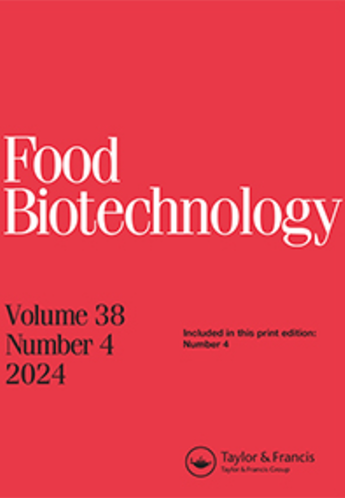在酵母生物反应器模型中进行咖啡豆发酵的微生物学、物理化学和感官研究
IF 1.6
4区 农林科学
Q4 BIOTECHNOLOGY & APPLIED MICROBIOLOGY
引用次数: 8
摘要
咖啡种植者使用传统的发酵方法去除咖啡豆周围的樱桃果肉。本研究的目的是评估在受控酵母生物反应器模型(New Brunswick™BioFlo®)中进行的咖啡豆发酵的微生物学、物理化学和感官方面。在添加或不添加选定的酵母菌发酵剂(即毕赤酵母YC5.2)的情况下进行发酵,并研究了不同的参数,包括微生物生长、细菌多样性、接种持久性、糖消耗和代谢化合物形成(有机酸、乙醇和乙酸乙酯)。采用高效液相色谱、气相色谱-质谱联用技术对发酵后的咖啡豆进行化学成分分析,并用杯测法(SCA - specialty coffee association)对咖啡饮料进行感官分析。在酵母生物反应器模型下,酵母发酵剂生长良好,乙醇含量为0.136 g/L.h,乙酸乙酯含量为1.039 mg/L.h。Illumina高通量16S rRNA基因测序结果显示,细菌种群主要为Pediococcus sp.和Leuconostocaceae科。与传统工艺相比,该发酵系统还能够生产出具有丰富香气成分(包括d -柠檬烯、苯乙醛和苯乙醇)的咖啡豆和质量显著提高的饮料。随着进一步的改进,搅拌槽生物反应器(STR)模型可能有助于设计新的生物反应器,以优化咖啡发酵剂发酵。本文章由计算机程序翻译,如有差异,请以英文原文为准。
Microbiological, physicochemical and sensory studies of coffee beans fermentation conducted in a yeast bioreactor model
ABSTRACT Coffee growers use a traditional method of fermentation to remove the cherry pulp surrounding the beans. The aim of this study was to evaluate the microbiological, physicochemical, and sensory aspects of coffee beans fermentation conducted in a controlled yeast bioreactor model (New Brunswick™ BioFlo®). Fermentations were conducted with or without the addition of a selected yeast starter culture (viz., Pichia fermentans YC5.2) and different parameters, including microbial growth, bacterial diversity, inoculum persistence, sugar consumption, and metabolic compounds formation (organic acids, ethanol, and ethyl acetate), were investigated. The chemical composition of resulting fermented coffee beans was assessed by high‐performance liquid chromatography and gas chromatography–mass spectrometry, and sensorial analysis of coffee beverage was performed using the cupping test (SCA – specialty coffee association). The yeast bioreactor model enabled efficient yeast starter culture growth and ethanol (0.136 g/L.h) and ethyl acetate (1.039 mg/L.h) formation. The bacterial population was mainly represented by Pediococcus sp. and Leuconostocaceae family, as revealed by Illumina high-throughput 16S rRNA gene sequencing. The fermentation system also enabled the production of coffee beans with rich aroma composition (including D-Limonene, phenyl-acetaldehyde, and phenylethyl alcohol) and beverages with a remarkable increase in quality compared to the conventional process. With further refinements, the stirred-tank bioreactor (STR) model may be useful in designing novel bioreactors for the optimization of coffee fermentation with starter cultures.
求助全文
通过发布文献求助,成功后即可免费获取论文全文。
去求助
来源期刊

Food Biotechnology
工程技术-生物工程与应用微生物
CiteScore
3.80
自引率
0.00%
发文量
15
审稿时长
>12 weeks
期刊介绍:
Food Biotechnology is an international, peer-reviewed journal that is focused on current and emerging developments and applications of modern genetics, enzymatic, metabolic and systems-based biochemical processes in food and food-related biological systems. The goal is to help produce and improve foods, food ingredients, and functional foods at the processing stage and beyond agricultural production.
Other areas of strong interest are microbial and fermentation-based metabolic processing to improve foods, food microbiomes for health, metabolic basis for food ingredients with health benefits, molecular and metabolic approaches to functional foods, and biochemical processes for food waste remediation. In addition, articles addressing the topics of modern molecular, metabolic and biochemical approaches to improving food safety and quality are also published.
Researchers in agriculture, food science and nutrition, including food and biotechnology consultants around the world will benefit from the research published in Food Biotechnology. The published research and reviews can be utilized to further educational and research programs and may also be applied to food quality and value added processing challenges, which are continuously evolving and expanding based upon the peer reviewed research conducted and published in the journal.
 求助内容:
求助内容: 应助结果提醒方式:
应助结果提醒方式:


